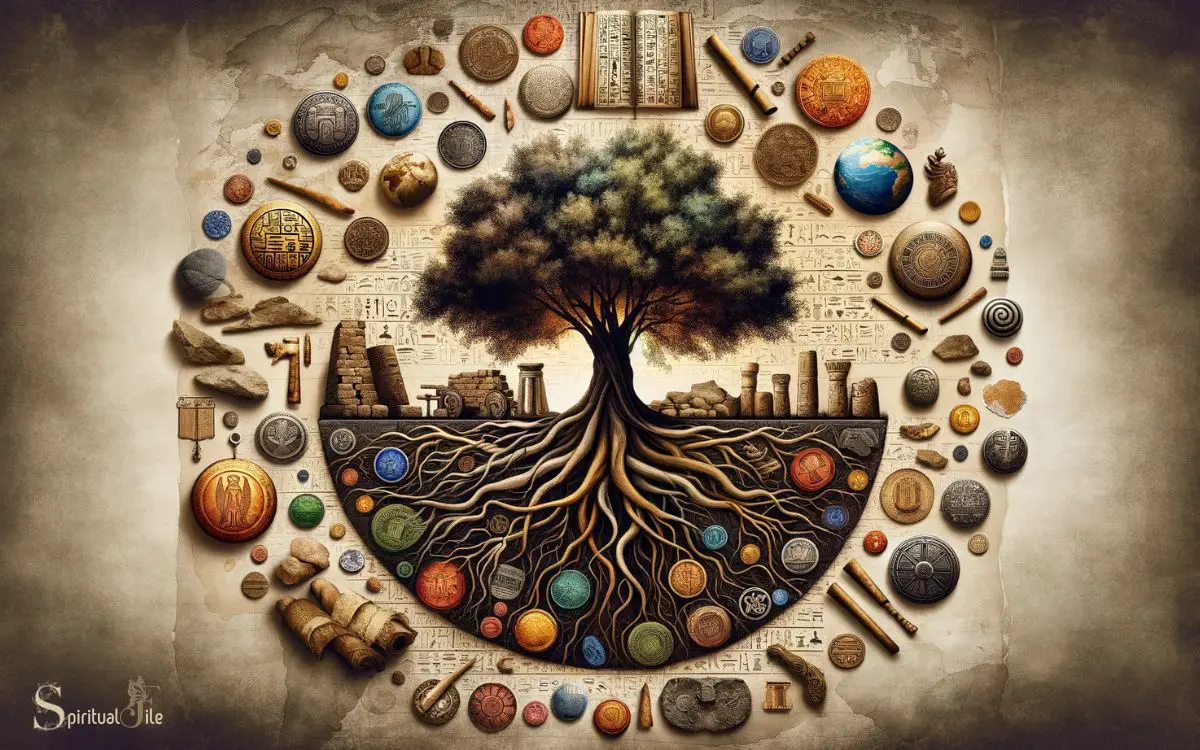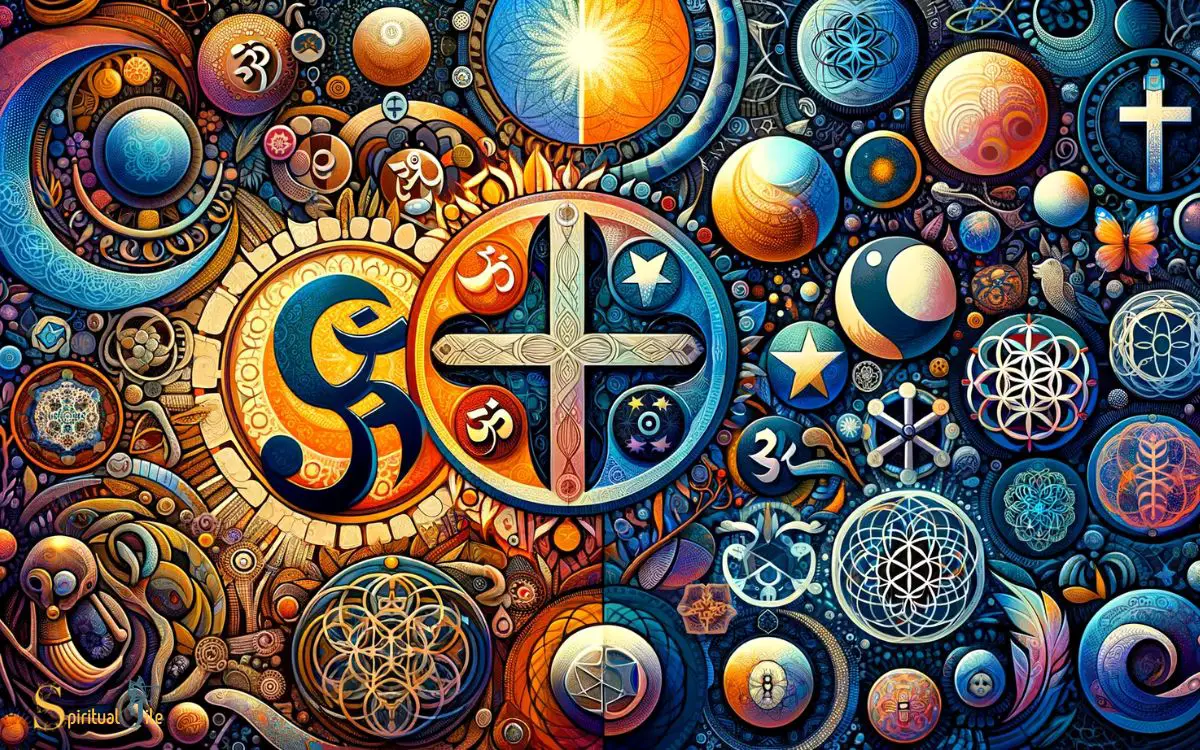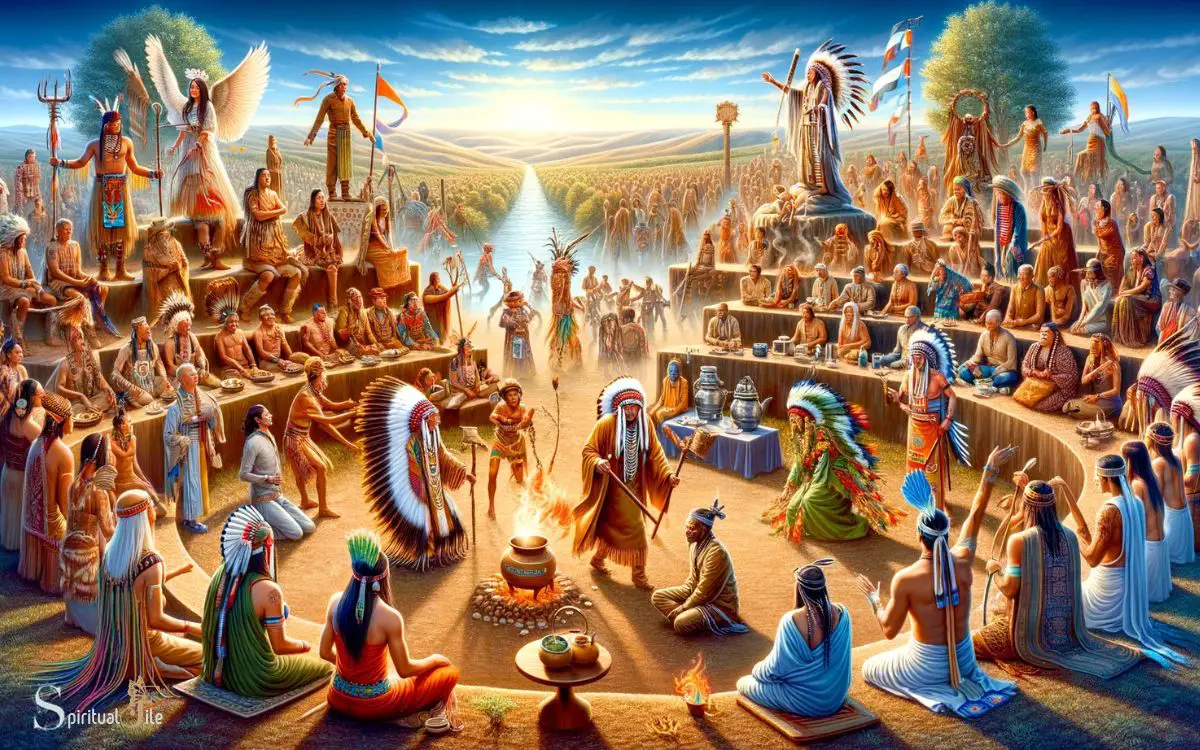Native American Spirituality Vs Christianity: Practices!
The distinction between Native American spirituality and Christianity lies in their beliefs, practices, and historical development.
Native American spirituality is diverse, reflecting the varied cultures of indigenous peoples, and it often centers around a deep connection with nature, ancestral spirits, and community rituals.
Christianity, based on the life and teachings of Jesus Christ, emphasizes salvation, the Holy Trinity, and the church’s role in guiding its followers’ spiritual lives.
Native American spirituality is not a single religion but a mosaic of spiritual practices among different tribes.
Common elements include:
- A belief in a sacred, interconnected natural world
- Reverence for ancestral spirits
- Oral traditions and storytelling
- Ceremonies that mark life transitions and seasonal changes
In contrast, Christianity is a monotheistic religion with key beliefs including:
- The divinity of Jesus Christ
- The concept of original sin and redemption
- The Bible as the sacred scripture
- The importance of sacraments and worship in churches
Examples of how these spiritual paths diverge and sometimes intersect include syncretic practices like the Native American Church, which blends elements of Christianity with indigenous beliefs.

Key Takeaway
9 Aspects: Native American Spirituality Vs Christianity
| Aspect | Native American Spirituality | Christianity |
|---|---|---|
| Beliefs | Animistic, nature-centered, polytheistic | Monotheistic, belief in one God |
| Creation Myth | Emphasis on earth and nature creation | Belief in God as the creator of all |
| Deities | Multiple spirits and deities | God, Jesus Christ, Holy Spirit |
| Worship | Rituals, dances, ceremonies | Church services, prayer, sacraments |
| Afterlife | Diverse beliefs, often tied to nature | Heaven and Hell, salvation through faith |
| Moral Code | Respect for nature, community, and balance | Ten Commandments, teachings of Jesus |
| Scriptures | Oral traditions, stories, and legends | Bible (Old and New Testaments) |
| Conversion | Rarely seek converts, focus on tradition | Active proselytizing and mission work |
| Symbols | Totems, animals, elements | Cross, Bible, dove, fish, symbols of faith |
Historical Roots and Origins

The historical roots and origins of Native American spirituality and Christianity can be traced back to distinct cultural, geographical, and historical contexts.
Native American spirituality is deeply intertwined with the land, traditions, and oral histories of various indigenous tribes. It embodies a profound connection to nature and the belief in the interconnectedness of all living things.
On the other hand, Christianity has its origins in the teachings and life of Jesus Christ, rooted in the ancient Middle East. It spread through various historical events and has been shaped by diverse cultural influences.
Understanding the historical context of both belief systems is crucial in comprehending their development and the ways in which they have intersected or diverged over time.
Belief Systems and Worldviews

Rooted in the interconnectedness of all living things, Native American spirituality and Christianity manifest distinct belief systems and worldviews.
Native American spirituality revolves around a deep connection to nature and the belief that all living beings, including animals, plants, and humans, are interconnected and interdependent.
This worldview emphasizes harmony and balance with the natural world and the importance of living in unity with all creation.
In contrast, Christianity is centered on the belief in one God, the divinity of Jesus Christ, and the idea of salvation through faith in Christ.
It emphasizes a personal relationship with God and the adherence to specific moral and ethical principles outlined in the Bible.
These differing belief systems shape the perspectives and values of their respective followers, influencing their understanding of the world and their place within it.
This contrast sets the stage for exploring how these belief systems are expressed through rituals and ceremonies.
Rituals and Ceremonies

Manifestations of spirituality in rituals and ceremonies reveal the profound differences between Native American spirituality and Christianity.
In Native American spirituality, rituals and ceremonies are deeply intertwined with the natural world, reflecting a profound reverence for the earth and its elements.
These ceremonies often involve practices such as smudging, vision quests, and the use of sacred herbs. They are seen as a means of connecting with the spiritual realm and maintaining harmony with the natural world.
Conversely, in Christianity, rituals and ceremonies are often centered around the church and its sacraments, such as baptism, communion, and confession. These practices are viewed as a way to connect with God and receive His grace.
The contrasting focus on nature and the church in rituals and ceremonies highlights the differing spiritual perspectives of Native American spirituality and Christianity.
Concept of Deity and Spirituality

The concept of deity and spirituality is central to understanding the differences between Native American spirituality and Christianity.
One key point of divergence is the diversity of deities and spirits in Native American spirituality, compared to the monotheistic belief in one God in Christianity.
Additionally, Native American spirituality is often nature-centric, emphasizing the interconnectedness and reverence for the natural world, while Christianity tends to be more anthropocentric, focusing on the relationship between God and humanity.
Deity Diversity and Oneness
In the context of Native American spirituality and Christianity, the concept of deity diversity and oneness has been a point of comparison and contrast for centuries.
- Deity Diversity: Native American spirituality acknowledges a diverse array of deities, spirits, and forces, each with its own significance and role in the natural and spiritual world. This diversity reflects the rich tapestry of their cultural and spiritual beliefs.
- Oneness: Christianity, on the other hand, emphasizes the oneness of God, believing in one all-powerful, all-knowing deity who created the universe and governs it with divine providence. This singular focus on a monotheistic deity sets it apart from the polytheistic tendencies found in Native American spirituality.
- Harmony and Understanding: While these belief systems differ in their approach to deity diversity and oneness, both seek harmony and understanding with the divine, expressing the fundamental human desire for spiritual connection and meaning.
Nature-Centric Vs. Anthropocentric
The contrast between Native American spirituality’s nature-centric concept of deity and Christianity’s anthropocentric concept is fundamental to understanding their divergent spiritual perspectives.
Native American spirituality views the natural world as sacred, with deities often being associated with natural elements such as animals, plants, and celestial bodies.
This perspective emphasizes harmony with nature, recognizing humans as part of a larger interconnected web of life.
In contrast, Christianity’s anthropocentric concept places humans at the center of the divine plan, with a transcendent deity who created the world for human use. This perspective tends to emphasize human dominion over nature.
These differing concepts of deity and spirituality have profound implications for how each culture interacts with and perceives the natural world, shaping their values, traditions, and societal norms.
Moving forward, it is essential to explore how these differing spiritual perspectives influence societal norms and the treatment of the environment.
Impact on Societal Norms

Gender roles and relationships with nature are two key areas where these belief systems diverge, influencing how individuals and communities interact with the world around them.
Understanding these differences can provide valuable insights into the cultural dynamics at play within Native American and Christian communities.
Gender and Roles
Gender roles in Native American spirituality and Christianity significantly influence societal norms.
In Native American spirituality:
- Equality: Many Native American tribes traditionally held egalitarian views, where both men and women played vital roles in the community.
- Respect for Diversity: Some tribes recognized more than two genders, acknowledging the presence of Two-Spirit individuals who possessed both masculine and feminine qualities.
- Leadership: Women often held positions of leadership and power within their communities, contributing to decision-making processes and spiritual practices.
These perspectives on gender roles have shaped societal norms within Native American communities.
In Christianity:
- Traditional Roles: There is often an emphasis on traditional gender roles, with men typically holding leadership positions within the church.
- Patriarchal Structure: Many Christian denominations uphold a patriarchal structure, where men are viewed as the spiritual authority within the family and community.
- Limited Leadership Opportunities: Some Christian traditions restrict women from holding certain leadership positions within the church.
These perspectives on gender roles have shaped societal norms within Christian communities.
These differing perspectives on gender roles have shaped societal norms within Native American and Christian communities, impacting everything from family dynamics to community leadership. This, in turn, influences the relationship with nature.
Relationship With Nature
In considering the impact of the relationship with nature on societal norms within Native American spirituality and Christianity, a profound interconnectedness with the environment shapes cultural and behavioral attitudes.
Native American spirituality emphasizes a deep reverence for nature, viewing all elements of the natural world as interconnected and imbued with spiritual significance.
This perspective influences societal norms by promoting environmental stewardship, sustainability, and a holistic approach to living in harmony with the earth.
In contrast, while Christianity acknowledges the importance of nature as a divine creation, its focus on human dominion over the earth has historically led to a more anthropocentric worldview, impacting societal norms by shaping attitudes towards resource utilization and conservation.
Understanding these differing perspectives on the relationship with nature is crucial in comprehending the broader societal implications of Native American spirituality and Christianity. This sets the stage for examining the complexities of cultural appropriation and syncretism.
Cultural Appropriation and Syncretism

Cultural appropriation and syncretism have played a significant role in the interaction between Native American spirituality and Christianity.
This has resulted in complex dynamics, including:
- Loss of Cultural Identity: The adoption of Native American spiritual practices by non-indigenous individuals has often led to the misrepresentation and commodification of sacred rituals, undermining their true cultural significance.
- Syncretism and Adaptation: Over time, some Native American communities have incorporated Christian beliefs and practices into their spirituality, resulting in a blend of traditions that reflect the complexities of cultural exchange.
- Struggles for Authenticity: Many Native American communities continue to face challenges in preserving their spiritual traditions in the face of cultural appropriation, seeking to maintain the authenticity and integrity of their beliefs.
These dynamics have shaped the modern-day relevance and challenges faced by both Native American spirituality and Christianity in their interactions.
Modern-Day Relevance and Challenges

Amidst ongoing cultural exchange and adaptation, navigating the modern-day relevance and challenges of Native American spirituality and Christianity requires a nuanced understanding of their historical interactions.
In today’s world, both Native American spirituality and Christianity face the challenge of preserving their traditions and beliefs in the face of globalization and modernization.
Native American spirituality grapples with issues of cultural appropriation and the preservation of sacred rituals and practices in a rapidly changing world.
On the other hand, Christianity continues to adapt to diverse cultural contexts while also contending with its historical role in the colonization and suppression of Native American traditions.
Both belief systems must now navigate the complexities of maintaining relevance and authenticity in a world where traditional practices intersect with contemporary influences.
Understanding and respect are crucial in addressing these modern-day challenges.
What are the differences in spiritual practices between Native American and Kemetic spirituality compared to Christianity?
Native American spirituality and Kemetic spirituality rituals vs Christianity differ in their belief systems and practices. Both native and kemetic spiritualities emphasize the interconnectedness of all life and the importance of respecting nature. In contrast, Christianity focuses on the worship of one God and the teachings of Jesus Christ.
Frequently Asked Questions
How Have Native American Spirituality and Christianity Influenced Each Other Over Time?
Over time, Native American spirituality and Christianity have influenced each other through cultural exchange, intermarriage, and the adoption of certain beliefs and practices.
This interaction has contributed to the evolution of both traditions.
What Are the Differences in the Roles of Women in Native American Spirituality and Christianity?
The roles of women in Native American spirituality and Christianity differ in their societal and religious significance.
While Native American spirituality often emphasizes the importance of women as caretakers and spiritual leaders, Christianity traditionally assigns women more subordinate roles within the faith community.
How Do Native American Spiritual Beliefs and Christian Beliefs Approach Environmental Stewardship and Conservation?
Both Native American spiritual beliefs and Christian beliefs emphasize the importance of environmental stewardship and conservation.
They both recognize the interconnectedness of all living beings and the responsibility to care for the earth.
What Are the Traditional Healing Practices in Native American Spirituality and How Do They Compare to Christian Approaches to Healing?
Traditional healing practices in Native American spirituality often involve herbal remedies, ceremonies, and spiritual connections.
These practices emphasize harmony with nature and the interconnectedness of all living beings. In comparison, Christian approaches to healing often center around prayer, faith, and medical interventions.
How Do Native American Spiritual Leaders and Christian Religious Leaders Interact and Collaborate in Modern Society?
In modern society, Native American spiritual leaders and Christian religious leaders interact and collaborate on various societal issues, fostering understanding and shared values.
Their engagements often focus on community service, social justice, and promoting dialogue for mutual respect and cooperation.
Conclusion
The clash between Native American spirituality and Christianity highlights the ongoing struggle for cultural dominance and religious superiority.
The history of colonization and forced conversion continues to impact the modern-day relevance of these belief systems, leading to cultural appropriation and syncretism.
As society grapples with the challenges of reconciling these two worldviews, it becomes clear that the quest for spiritual enlightenment often comes at the cost of cultural assimilation and the erasure of indigenous traditions.






